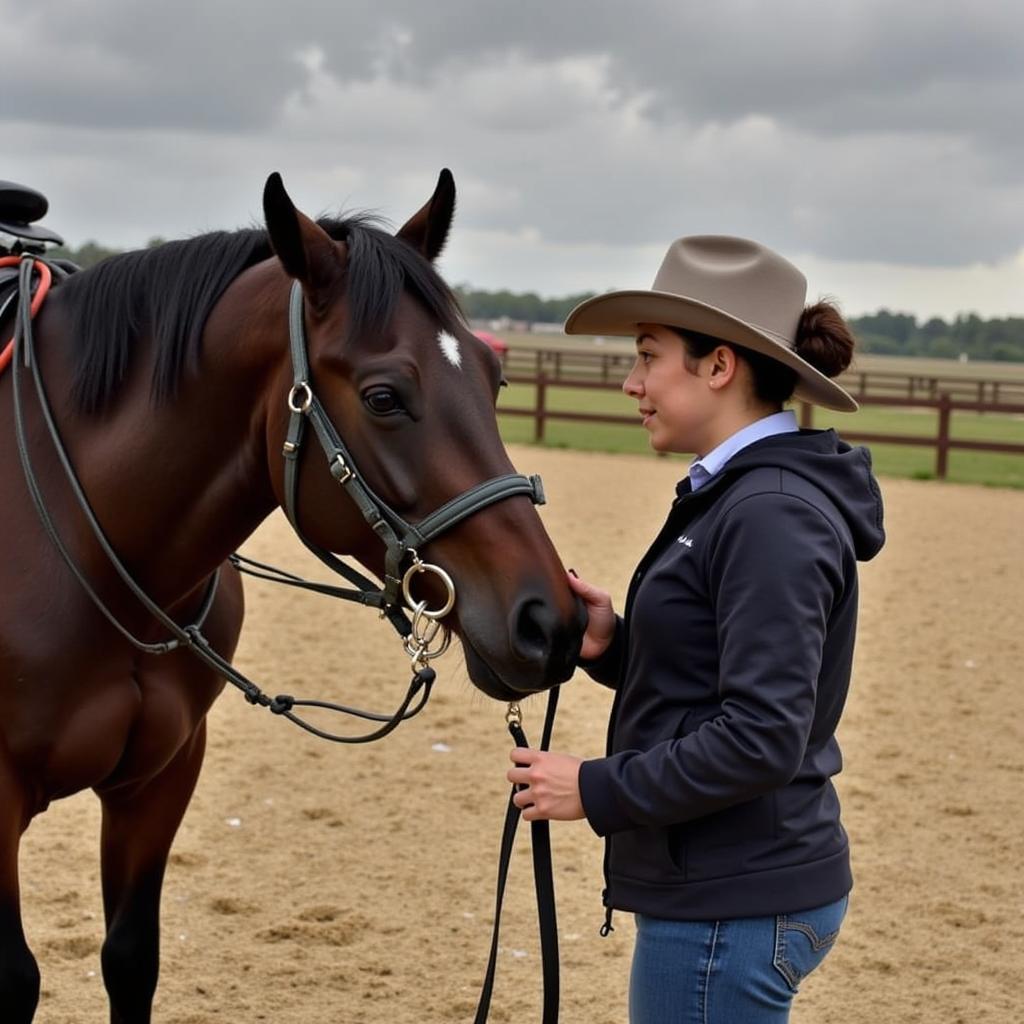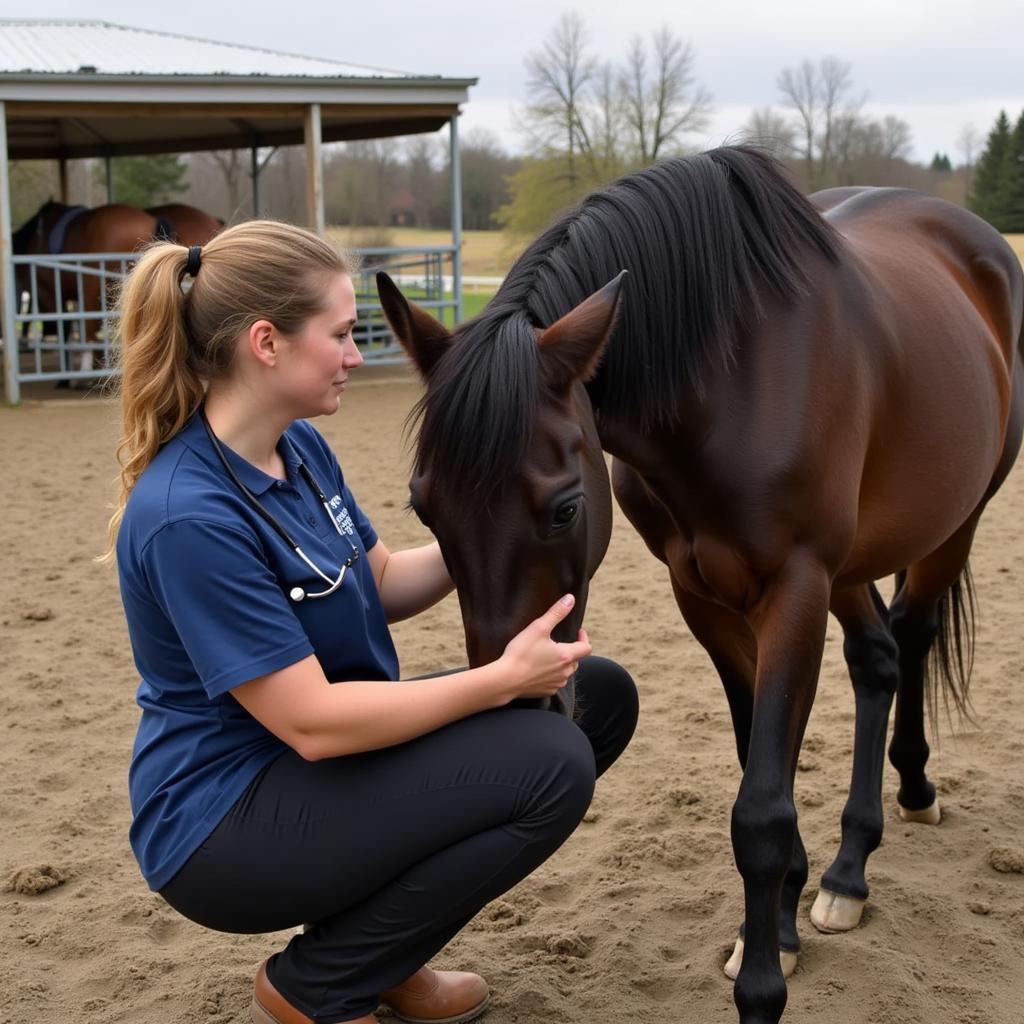When it comes to equine sports, few disciplines demand the grace, athleticism, and sheer partnership as gymnastics on horseback, also known as vaulting. This demanding sport requires a horse with a unique temperament and physicality. Choosing the right Horse For Gymnastics is crucial for both the safety and success of the vaulter and the well-being of the horse. But what exactly should you be looking for in a horse for gymnastics?
 Horse Vaulting Competition
Horse Vaulting Competition
Key Considerations When Selecting a Horse for Gymnastics
While it might be tempting to focus solely on breed, several factors beyond lineage contribute to a horse’s suitability for this unique discipline.
Temperament: The Cornerstone of a Vaulting Horse
More than any physical attribute, temperament reigns supreme. A vaulting horse must possess an unflappable demeanor, remaining calm and composed amidst the movements and noise of vaulters. Look for a horse that is:
- Bombproof: Unreactive to sudden noises, movements, and unfamiliar environments.
- Patient: Tolerant of the mounting, dismounting, and movements of vaulters, especially beginners.
- Reliable: Consistent in gait and response to cues, ensuring a safe and predictable experience for the vaulter.
- Gentle: Possessing a kind and willing disposition, making them enjoyable partners for both horse and vaulter.
Physical Attributes: Conformation and Gaits
Beyond temperament, certain physical characteristics contribute to a horse’s suitability for vaulting:
- Size and Strength: Vaulting horses need to be strong enough to carry the weight of the vaulter and the equipment. While size can vary, most vaulting horses are at least 15.2 hands high and solidly built, with Warmbloods and draft crosses being popular choices.
- Smooth Gaits: A rhythmic, steady canter is crucial. The canter should be adjustable, allowing the vaulter to perform their routines with balance and precision.
- Back Conformation: A broad, short-coupled back with well-sprung ribs is ideal for weight-bearing and provides a stable platform for vaulting exercises.
- Soundness: Given the demands of the sport, a history of lameness or soundness issues is a significant red flag.
Age and Experience: Finding the Right Fit
While younger horses can be trained for vaulting, horses between 8 and 15 years old are often preferred. They are typically mature enough physically and mentally for the demands of the discipline yet still have many active years ahead of them. Prior experience in vaulting or disciplines requiring similar temperaments (like therapeutic riding) can be a bonus.
 Assessing Temperament for Vaulting
Assessing Temperament for Vaulting
Breeds Known for Vaulting Prowess
While temperament and individual characteristics are paramount, some breeds are renowned for their suitability for vaulting:
- Warmbloods: Bred for dressage and show jumping, Warmbloods often possess the ideal combination of strength, athleticism, and temperament for vaulting.
- Draft Horses and Draft Crosses: Their calm nature, strength, and broad backs make them well-suited for the demands of vaulting, especially for larger teams.
- Quarter Horses: Known for their calm temperaments and trainability, Quarter Horses can excel in vaulting, especially with careful selection for size and movement.
“It’s crucial to remember that breed alone is not a guarantee of suitability,” says renowned vaulting coach, Sarah Williams. ” A horse’s individual temperament, training, and physical condition are far more critical than its pedigree.”
Evaluating a Potential Vaulting Horse
When considering a horse for vaulting, it’s crucial to conduct a thorough evaluation, including:
- Temperament Assessment: Observe the horse’s reactions to various stimuli, such as sudden noises, unfamiliar objects, and being touched in different areas.
- Movement Evaluation: Assess the horse’s gaits, particularly the canter, for smoothness, rhythm, and adjustability.
- Veterinary Examination: A thorough vet check, including lameness exams and back x-rays, is essential to ensure the horse is physically sound.
 Veterinarian Examining Horse for Vaulting
Veterinarian Examining Horse for Vaulting
Conclusion: A Partnership Built on Trust
Choosing a horse for gymnastics is a significant decision that requires careful consideration of temperament, physicality, and experience. By prioritizing these factors and seeking expert guidance, you can find a horse that will not only excel in the sport but also become a trusted partner for the vaulter. Remember, the ideal vaulting horse is more than just an athlete; it’s a teammate, a confidant, and a crucial part of a successful and fulfilling vaulting journey.
Frequently Asked Questions (FAQs)
1. Can any horse be used for vaulting?
No, not all horses are suitable for vaulting. Temperament, conformation, and training play a crucial role in determining a horse’s aptitude for this demanding discipline.
2. What is the best age for a vaulting horse?
Horses between 8 and 15 years old are often preferred, as they typically possess the right combination of physical maturity, mental stability, and years of potential service.
3. How much does a vaulting horse cost?
The price of a vaulting horse can vary widely depending on factors like breed, training, age, and location. However, expect to pay a premium for a horse with proven experience and success in the discipline.
4. Do vaulting horses need special training?
Yes, vaulting horses require specialized training to acclimate them to the movements and equipment used in the sport. They must learn to maintain calm and consistent gaits even with a vaulter on their back.
5. Where can I find a vaulting horse for sale?
Reputable breeders, trainers, and equestrian organizations specializing in vaulting are excellent resources for finding a suitable horse.
Need Help Finding the Perfect Vaulting Partner?
We’re here to assist you in your search! Contact us at Justus Horses USA:
Phone: 0772127271
Email: [email protected]
Address: QGM2+WX2, Vị Trung, Vị Thuỷ, Hậu Giang, Việt Nam
Our team of experts is available 24/7 to answer your questions and guide you toward finding the ideal horse for your vaulting journey.